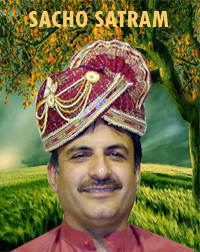In one of his beautiful and illuminating satsangs, Hazir Swaroop Sai Sadhram Sahib emphasized the importance of unwavering ambition.
If a person has a firm determination to achieve something, then he cannot be stopped by any hurdles or obstacles. A person should acquire strength, intellect, and the will to successfully fulfill any ambition. To complete any ambition, a person needs the energy to work towards finishing his tasks. He should also be wise and sensible to execute his work properly. Most importantly, a person should have a strong belief in himself. He should believe that nothing can bend or destroy him until he achieves his ambition, and he will remain resilient and alive until then.
We, as humans, may believe in reincarnation, but we should always have the courage and aspiration to achieve our ambitions in this lifetime. Our yearning to fulfill our ambitions should be very strong.
To attain the capability to achieve an ambition, one should immerse oneself in the practices of NAAM, DHYAN, SIMRAN. Engaging in Naam, Dhyan, and Simran enables a person to acquire the necessary strength, intellect, and longevity required for the realization of his ambition. These three elements are obtained simultaneously, encompassing willpower to accomplish the ambition, enhanced intellect, and an extended lifespan. By judiciously observing each breath during the practice of Naam, Jaap, and Simran, individuals harness the power of their breaths to gain energy, intelligence, and a prolonged life.
Sai Sadhram Saheb pointed out that if we observe, a dog lives for 20 to 25 years, a human being lives for around 80 to 100 years, or perhaps a few years less or more, but a tortoise lives for 400 to 500 years.
The actual reason behind this is that the dog breathes very rapidly, it’s tongue is always out, and it keeps gasping for breath. A dog continuously breathes heavily without pausing. Normally, the breathing rate of a dog is between 25-30 breaths per minute. A dog’s breathing is always very heavy and fast, and due to this, we can observe that the dog becomes hyper very quickly. A dog gets anxious and excited very rapidly due to its breathing patterns.
When a car passes by a dog, it instinctively tries to chase it without any apparent reason. Even if the car’s windows and doors are closed, the dog may continue running behind it, barking, sometimes causing harm to itself. We are all familiar with the saying that someone died a dog’s death, indicating an unpleasant and demeaning demise.
Similarly, when a person takes rapid breaths, his mind operates at an accelerated pace, and he may apply less common sense. A talkative person tends to speak extensively without filtering his speech, lacking awareness of the purpose of his words. He may keep babbling without reason and struggle to discern where to begin or end. Asking something from a talkative person may lead to unrelated responses, as that person may not know where to start or conclude. Similarly, a dog breathes rapidly, and its mind is not under control, resulting in a constant state of hyperactivity.
Hazir Swaroop Sai Sadhram Saheb further explained that human beings breathe almost 15 to 16 times per minute. Due to taking fewer breaths, human beings use their minds wisely and think before they act. Because of the reduced breath rate, humans live longer, typically ranging from 80 to 100 years.
Observing a tortoise, we notice that it takes only 4 to 6 breaths per minute. Despite this minimal breathing rate, a tortoise has a remarkable lifespan, living for almost 400 to 500 years. The tortoise remains relatively stationary, spending extended periods quietly inside its shell without much movement. This nature contributes to the accumulation and strength of its willpower, intelligence, and resilience. Interestingly, a tortoise remains unperturbed even if a heavy vehicle passes over its shell.
The intelligence of a tortoise becomes evident when it senses danger; it promptly withdraws its head inside its shell, remaining still and silent. While water evaporates at 100 degrees Celsius, and even iron can evaporate at certain temperatures, a bomb, when detonated, releases such intense heat that it can destroy everything. In areas where abomb is detonated, no life can survive, and all buildings, including the iron used in them, evaporate and burn. However, the unique resilience of a tortoise allows it to survive even in the aftermath of a bomb, a feat unmatched by any other species. Tortoises are great survivors of this world and have made it through many extinctions around them.
Sai emphasized that the longer we engage in Naam, Dhyan, and Simran, the more positive energy we receive, the greater our strength becomes, and our intelligence sharpens. Our memory power improves, our sensibility increases, and our energy and strength gain more power. Consequently, we will naturally refrain from talking excessively or foolishly, opting to speak less and conserve our energy. The continuous attention to our breathing will maintain our calmness, and we will preserve energy by responding succinctly or not responding to every inquiry, thereby avoiding unnecessary discussions.
Through meditation, namely Naam Jaap, we can extend our lifespan with vitality and dignity, as this practice aids in conserving our breaths for a longer life. Engaging in meditation allows us to make well-informed decisions with heightened awareness. We gain the ability to discern genuine advice from provocation, understand people’s behavior, and discern their intentions. Furthermore, we can conserve our energy, enhance our intelligence, and fortify our willpower discreetly. Armed with these qualities, success in achieving our ambitions becomes attainable.



